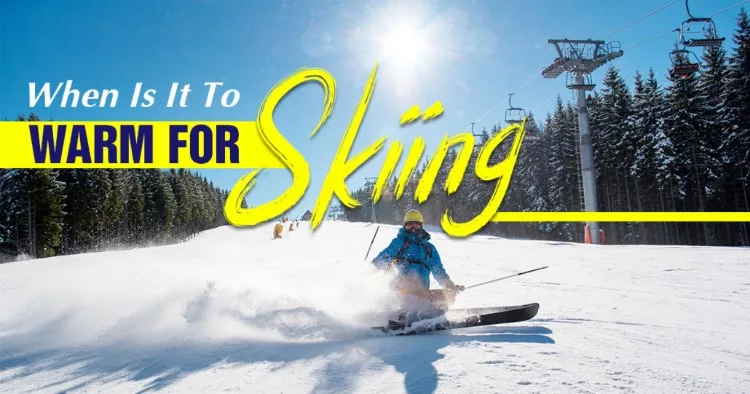How Warm Is Too Warm For Skiing?
by Frank V. Persall
One of the most popular winter sports in the world is snow skiing. If you haven't yet gotten a chance to snow ski, you're probably from a warm or humid country where snowfall is out of the question. The sport is famous amongst all age groups worldwide. Snow skiing involves sliding over the snow with the help of specific equipment called skis or ski boards and other safety equipment.

Snow skiing was the first type of skiing invented. Later on, people revolutionized land skiing, grass skiing, and other sports, which allow you to move over surfaces.
There are several types of snow skiing, out of which the most known include snowboarding, freestyle skiing, and Alpine skiing. People from warmer cities often travel to cold areas having plenty of snow to fulfill their leisure pursuit of skiing. Though there are a few factors, one must consider out of which the primary consideration is the weather.
Ideal Skiing Temperature
As the name suggests, snow skiing is furthermost dependent on snow conditions. So before you go snow skiing, you have to keep in mind the type and consistency of snow, to ensure safe and smooth skiing.
Snow conditions are dependent on the temperature of the ski resort or skiing location. It's best to have an insight on snow conditions ideal for skiing to avoid mishaps.
In case you're wondering, the various types of snow include fresh snow, which is any skiers' or snowboarders' top priority. Why? Well, because heavy and fresh snow sprinkles allow skiers to make fast and smooth turns as they pave new tracks to ski over hills and smooth surfaces.
The second most preferred type of snow by skiers includes powder snow. This type of snow is one of the most popular snow conditions amongst mountains. When there has been heavy snowfall which has lesser moisture and a more compact structure, skiers feel like they're floating over the snow. Sounds magical!
When snow takes a powdered form, due to compressing and smoothening by the piste basher, it's referred to as packed powder. This type of snow makes a great base for skiers. It allows skiers to ski freely on the layers of powdered snow, creating a smooth platform.
Another type of snow, known as icy or hard-packed snow, is found upon hills. This type of snow is a result of the increase of water content within the snow. It is not recommended as the ice may get slippery, which could lead to loss of control during skiing or make it tougher for some skiers to ski on.
One of the most challenging types of snow for skiing, Found within warmer mountains, is slush snow. When the hard-packed ice starts to melt, it adapts a slushy texture. The slushy snow is often a welcome to spring skiing. It also welcomes afternoons enjoying sunshine amongst the melting snow. So it's not so bad after all. Although skiers do not prefer slushy snow, it still has many pros.
An uncommon type of snow is sticky snow. Like slush snow, sticky snow forms when the temperature starts to rise, leading the snow to melt. This type of snow is least preferred by skiers, as the wet snow forms a vacuum under the ski. The vacuum makes it hard for skiers to move smoothly and at a faster pace.
Just as snow skiing is dependent on snow conditions, snow conditions are dependent upon the surrounding weather. If the temperature is too low, it leads to poor skiing conditions.
As seen in the 2010 winter Olympics in Vancouver, due to bad snow conditions, the management of the event had to import snow from a park nearby to replace the thawing snow present there.
The temperature of a place determines the snow conditions and must be considered for ski events. The ideal snow conditions for skiing are often found in temperatures from -6 to -1 degrees Celsius. Albeit as temperatures are rising globally, thanks to climate change, it's hard to determine the perfect skiing conditions.
You are likely to find a good snow platform in the temperatures ranging from -6 to -1 degrees. This means the snow is perfect in consistency for skiing, rather than too hard or too slushy, having higher water consistency.
Although a temperature slightly higher than the ideal would work fine as well. In case the ice melts during the day yet freezes over the night, it keeps the snow intact. Still, one must consider how warm is too warm for skiing, to avoid inconvenience.
Skiing In Warm Weather
Imagine skiing on a warm day, going up to 35-40 degrees, sounds amazing, no? Isn't skiing a winter sport, though? Yes, but in some parts in the Midwest, snow is still present from the winters.
Leftover snow means there's still time to get sporty with your skis and snowboards. It's important to consider how warm is too warm for skiing, before planning a ski trip during spring though.
Although skiing in warm weather is not ideal for advanced skiers, during spring, ice starts to melt and begins to form a slushy structure that slows the skiers down. But isn't that ideal for beginners? Yes, someone who isn't professional at skiing yet.
It's ideal for beginners to kick start their passion for skiing on slushy ice, to get a hold of it easily without putting themselves in danger. The snow will slow them down with its heavier and wetter texture, making it safe.
If you're new to skiing and it is spring, you're in luck-no need to wear multiple layers of clothing. In fact, trade your goggles for sunglasses—time to ski with style and comfort.
Spring skiing surely sounds like a deal-breaker, but everything has its pros and cons. Similarly, it's best to ski mid-morning rather than early morning during spring. Simply because going early in the morning would mean encountering hard ice, so it's best to wait for the sun to shine and do its magic, making the ice rather slushy and ideal for skiing.
Another giveaway point for spring skiing is the cheaper tickets and resources. Thanks to spring for being not-so-famous skiing weather. Several ski resorts provide cheaper costs to get customers as skiing is more common in winters, and spring skiing is less common.
So you get to wear lesser clothing, get cheaper tickets, and enjoy the sunshine. Could this get any better? Well, there are a few things to consider as cons as well.
Firstly the scorching sun and thin mountain air could add up to cause a bad sunburn.
Sunscreen is essential to wear, goes without saying. Secondly, melting ice means exposed rocks and bumpy areas, skiers better watch out. The thinner the ice, the more exposed skiers are to edges, bumps, and rocks.
A very commonly asked question from people looking to ski is, how warm is too warm for skiing? People often state horror stories of unsuccessful ski trips due to lack of snow. Could that mean the rise in global temperature due to global warming is leading to melting ice and trouble for skiers? Highly possible!
Yes, skiing in warm weather is nice but not too warm as that would mean not enough ice is there to ski on. If the temperature isn't cold enough to refreeze the snow overnight suitable enough to ski, you can't ski then. In some cases, the day time temperature for skiing may range from 20 degrees to even 40 degrees, although only at a specific time during the day. If it's sunny all day long, the ice is likely to melt before evening.
As a matter of fact, 32 F is the freezing/melting point of water. Hence it's when the snow will start melting; this means any temperature above 32F is too warm for skiing.
Once snowfall reaches its peak, the temperature drops to 32F to melt the snow. Any temperature going above 32F will start melting the snow, and if it's snowing, the snowflakes will turn into raindrops.
Conclusion
The bottom line is that albeit snow skiing is a winter sport, known to be popular in winters, it's doable in spring. If you're looking to go on a ski trip, you know what factors to consider before going. The easiest way to determine whether the snow will be ideal for skiing, or even possible to ski on, is to check the temperature.
For any temperature too low, the snow will be too hard to ski on, and for any temperature too high, it'll be too slushy.
The ideal type of snow is fresh snow for skiers to freely slide over the snow and enjoy the beautiful and smooth ground surface. Snow in the spring is excellent for beginners only, as the dense and watery snow leads to slow skiing, that'll allow them to learn better.
There is an ideal temperature for skiing. If the temperature isn't cold enough to refreeze ice overnight and melts ice during the day, the snow will be too slushy and thin to ski on. It is possible to ski during temperatures ranging from 20 to even 40 degrees F; it's only possible in a few cases and suitable for those just skiing for entertainment rather than professionally.
Related Posts:
Which Mistakes Should A Beginner Avoid When Skiing
 |
 |
 |
 |

About Frank V. Persall
Frank is originally from the UK, but he has a passion for skiing that knows no bounds. He has made it his life's mission to visit the best ski resorts across the USA and the World. Frank loves spending time with his wife and three children on ski slopes, as they all share his love for the activity.
Thoughts on "How Warm Is Too Warm For Skiing?"
 |
 |
 |
 |
You can get FREE Gifts. Or latest free skiing books here.
Disable Ad block to reveal all the info. Once done, hit a button below
 |
 |
 |
 |